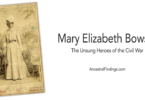While Harriet Tubman is well-known for her work freeing enslaved people via the Underground Railroad, far less is known of her admirable work as an armed scout, nurse, and spy for the Union during the Civil War. She received a military pension for this work and was buried with semi-military honors when she died in 1913. This is her incredible story.
Born approximately 1820 in Maryland (because no records were kept, she was unsure of her birth date, and it is listed in different places as anywhere between 1815 and 1825, Harriet was enslaved at birth, as both of her parents were slaves owned by white families who had been joined by marriage. At birth, her parents called her Araminta, and her nickname was Minty; she changed her first name to Harriet, after her mother, shortly after her marriage to John Tubman.
Harriet’s maternal grandmother, Modesty, was brought to America on a slave ship from Africa. Little is known about her other grandparents. Her parents were Ben Ross and Harriet Greene Ross, and she had four brothers and four sisters. As a child, she was hired out to other masters, beginning when she was five or six years old. These hired masters and mistresses often beat her for trivial offenses, such as letting a baby wake up and cry when she was supposed to be watching it sleep. Once, she recalled, she was beaten five times before breakfast and bore scars from the beatings for her whole life.
As a child, she also suffered a head injury when a plantation overseer threw a two-pound weight at a slave who was off the plantation without permission, and it hit her in the head instead. She believed her hair, which had never been brushed and stuck out stiff like a helmet, saved her life. She was unconscious for two days before being sent back into the field to work, but because she was still bleeding and unsteady from the injury, the master she was hired out to at that time sent her back to her home plantation. Her master tried unsuccessfully to sell her for years afterward.
After the head injury, Harriet suffered periodic seizures, narcoleptic-like episodes of sleep, and visions she said were brought to her by God.

A map of four key locations in the life of Harriet Tubman. (Wikipedia)
Her three older sisters were sold away from the family, and she never found them again. When a sale was being arranged for her youngest brother, her mother hid him for a month, then threatened both the master of the house and the man who wanted to buy the boy with bodily harm if they came near him. The potential buyer backed off the sale, and Harriet saw for the first time the good things resistance could bring.
Around 1840, Harriet’s father was granted his freedom as part of his previous owner’s will but continued to work for the family who had enslaved him, probably to be with his wife and children. Her mother was technically free by this same will, but the family did not recognize her freedom and continued to treat her as a slave.
Harriet married John Tubman, a free man of color, in 1844. By 1849, she made her first escape attempt with two of her brothers. Her brothers had second thoughts and returned, forcing her to go with them. She escaped again the same year on her own and reached freedom in Pennsylvania. Afterward, she took jobs to earn money that allowed her to make trips back into slave territory to rescue family members and other enslaved people who wanted their freedom. She eventually rescued her parents, her four brothers and their wives and children, and numerous other relatives, purchasing land in Auburn, New York as the family home. She tried to rescue her sister Rachel, who had been sold away from the family, but found Rachel had died and her two sons could only be rescued with a bribe of $30 each, which she did not have, so she was not able to bring them to freedom with her.
As a conductor on the Underground Railroad, she was considered the best, and once said she never lost a passenger. Anyone who went with her reached freedom.
Harriet also tried to rescue her husband, but he remarried in her absence and did not want to leave his new wife. She rescued other slaves on that trip, and John Tubman and his new wife raised a family together.
When the Civil War broke out, she went down to South Carolina and became a fixture in the Union camps, helping rescue slaves from plantations, and acting as a nurse to men with dysentery and smallpox (never contracting it herself, leading credence to the rumors that she was blessed by God). Initially, she received government rations for this work, but newly freed slaves resented it, so she gave up the rations and made her own money by selling pies and root beer she made in the evenings.
After the Emancipation Proclamation, Harriet became a scout, helping military leaders map unfamiliar areas in the south and get lists and locations of slaves who needed freeing. She worked under the orders of the Secretary of War for the Union and provided key intelligence that helped the Union capture Jacksonville, Florida.
That same year, she became the first woman to lead an armed assault during the Civil War. This assault on several plantations in South Carolina led to the liberation of more than seven hundred fifty slaves.
Harriet worked with the Union for more than two years and even volunteered a few months more of time with the Union Army after the Confederacy surrendered. Afterward, she returned to her family in Auburn, NY.
She spent the rest of her life helping newly freed slaves integrate into life as freed people, and assisting in the suffrage movement for women. She remarried, to Nelson Charles Davis, in 1869, and they adopted a baby girl named Gertie together in 1874. Nelson died in 1888 of tuberculosis.
In 1913, Harriet died at the assisted living home for former slaves she herself helped establish. She was buried with semi-military honors at Fort Hill Cemetery in Auburn, NY.






